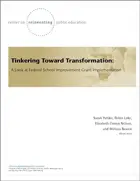In 2009, the federal government committed over $3 billion nationwide to help states and districts turn around their worst-performing schools. The U.S. Department of Education intended for the School Improvement Grants (SIGs) to spur dramatic change.
This report looks at the results of a field study of the first-year implementation of those grants in Washington State, which will receive $50 million in SIG funding over three years. CRPE researchers wanted to see what kinds of school-level changes are underway, how they compare to the intent of the grants, and the role that districts play in SIG implementation.
Researchers provide findings from the state, district, and school level. They found that, with some exceptions, districts and schools in Washington state are approaching the turnaround work in ways only marginally different from past school improvement efforts. Despite the hard work of administrators, principals, and especially teachers, the majority of schools studied show little evidence of the type of bold and transformative changes the SIGs were intended to produce.
The report offers recommendations regarding the roles that federal, state, and local education agencies should play in support of school turnaround work. Those administering future grants targeted at the nation’s lowest-performing schools could avoid the problems described here and improve their chances of affecting dramatic, not incremental, change.
An updated version of this report was republished in the Peabody Journal of Education, Volume 90, Issue 1, 2015.






